TrainingSchedule
关于训练预定计划表的三大流程
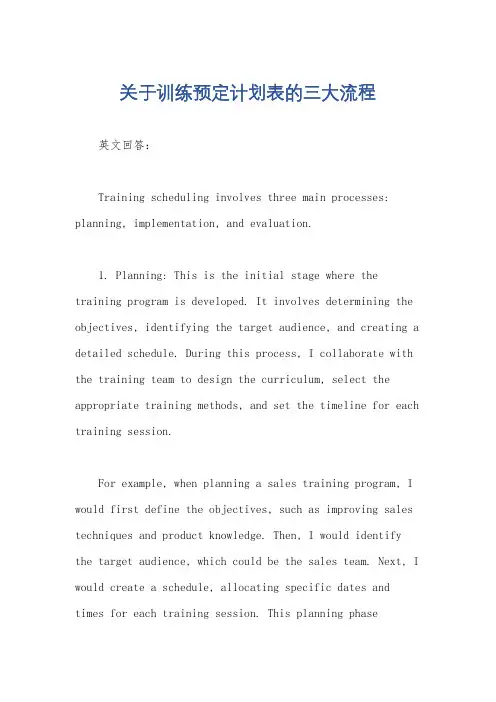
关于训练预定计划表的三大流程英文回答:Training scheduling involves three main processes: planning, implementation, and evaluation.1. Planning: This is the initial stage where the training program is developed. It involves determining the objectives, identifying the target audience, and creating a detailed schedule. During this process, I collaborate with the training team to design the curriculum, select the appropriate training methods, and set the timeline for each training session.For example, when planning a sales training program, I would first define the objectives, such as improving sales techniques and product knowledge. Then, I would identify the target audience, which could be the sales team. Next, I would create a schedule, allocating specific dates and times for each training session. This planning phaseensures that the training program is tailored to meet the needs of the participants.2. Implementation: Once the planning phase is complete, the training program is put into action. This involves delivering the training sessions according to the schedule. As the trainer, I would conduct the sessions, using various training methods such as presentations, role-plays, and group discussions. I would also provide relevant materials and resources to support the learning process.For instance, during a customer service training session, I would deliver a presentation on effective communication skills and then engage the participants in role-plays to practice handling customer inquiries. Throughout the implementation phase, I would encourage active participation and provide feedback to ensure that the participants are gaining the necessary knowledge and skills.3. Evaluation: The final stage of training schedulingis evaluation. This involves assessing the effectiveness ofthe training program and gathering feedback from the participants. I would use different evaluation methods,such as surveys, quizzes, and performance assessments, to measure the impact of the training.For example, after a leadership training program, I would distribute a survey to the participants to gathertheir feedback on the content, delivery, and overall experience. I would also analyze their performance before and after the training to determine if there has been any improvement. Based on the evaluation results, I can make adjustments to the training program for future sessions.In conclusion, training scheduling consists of planning, implementation, and evaluation. Each process is crucial for designing and delivering effective training programs. By carefully planning, delivering engaging sessions, and evaluating the outcomes, I can ensure that the participants receive valuable training that meets their needs.中文回答:培训预定计划表涉及三个主要流程,规划、实施和评估。
个人研修计划表
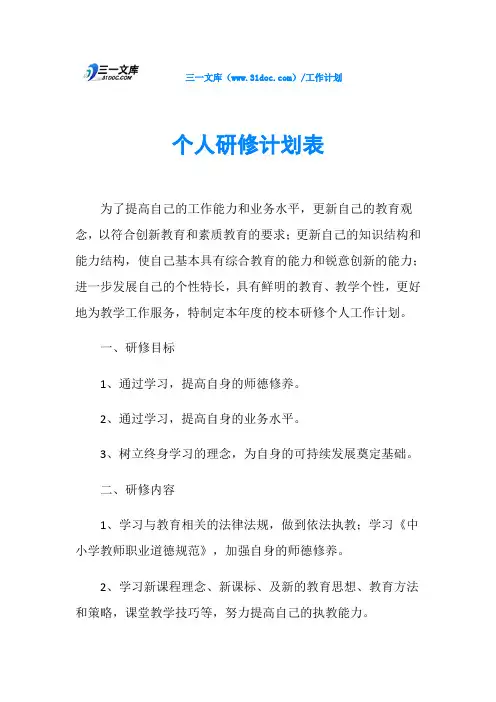
三一文库()/工作计划
个人研修计划表
为了提高自己的工作能力和业务水平,更新自己的教育观念,以符合创新教育和素质教育的要求;更新自己的知识结构和能力结构,使自己基本具有综合教育的能力和锐意创新的能力;进一步发展自己的个性特长,具有鲜明的教育、教学个性,更好地为教学工作服务,特制定本年度的校本研修个人工作计划。
一、研修目标
1、通过学习,提高自身的师德修养。
2、通过学习,提高自身的业务水平。
3、树立终身学习的理念,为自身的可持续发展奠定基础。
二、研修内容
1、学习与教育相关的法律法规,做到依法执教;学习《中小学教师职业道德规范》,加强自身的师德修养。
2、学习新课程理念、新课标、及新的教育思想、教育方法和策略,课堂教学技巧等,努力提高自己的执教能力。
3、学习有关家庭教育的思想和理论,努力做好与家长的沟通工作,为提高学生的家庭教育环境尽自己的努力。
4、广泛阅读各方面书籍,扩大自己知识面,提高综合能力。
三、具体措施及安排
1、每周利用1——2小时自学各种理论知识,并做好要点笔录,写专门的读书笔记上。
2、每年寒暑假读一本教育专著,并写好读书笔记和心得体会。
3、经常反思自己的教学行为和管理行为,不断地总结经验,找准不足之处,写好教学反思和案例,促进自己的不断进步。
4、在工作中对自己严格要求,决不松懈。
5、积极参加我校定期的听课、评课,进行教学研究,以解决自己教学中的疑难问题,让我的教学更具特色。
6、积极去校外听课,积极评课,博采众长。
比赛建议书英语作文初一
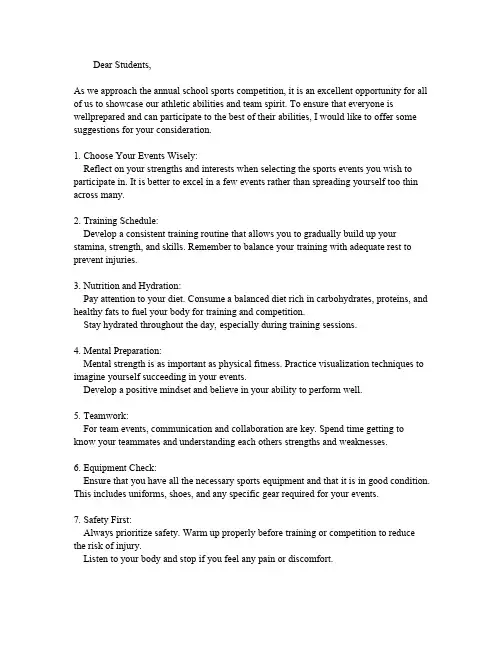
Dear Students,As we approach the annual school sports competition,it is an excellent opportunity for all of us to showcase our athletic abilities and team spirit.To ensure that everyone is wellprepared and can participate to the best of their abilities,I would like to offer some suggestions for your consideration.1.Choose Your Events Wisely:Reflect on your strengths and interests when selecting the sports events you wish to participate in.It is better to excel in a few events rather than spreading yourself too thin across many.2.Training Schedule:Develop a consistent training routine that allows you to gradually build up your stamina,strength,and skills.Remember to balance your training with adequate rest to prevent injuries.3.Nutrition and Hydration:Pay attention to your diet.Consume a balanced diet rich in carbohydrates,proteins,and healthy fats to fuel your body for training and competition.Stay hydrated throughout the day,especially during training sessions.4.Mental Preparation:Mental strength is as important as physical fitness.Practice visualization techniques to imagine yourself succeeding in your events.Develop a positive mindset and believe in your ability to perform well.5.Teamwork:For team events,communication and collaboration are key.Spend time getting to know your teammates and understanding each others strengths and weaknesses.6.Equipment Check:Ensure that you have all the necessary sports equipment and that it is in good condition. This includes uniforms,shoes,and any specific gear required for your events.7.Safety First:Always prioritize safety.Warm up properly before training or competition to reduce the risk of injury.Listen to your body and stop if you feel any pain or discomfort.8.Respect the Rules:Familiarize yourself with the rules of each event you are participating in.Adhering to the rules not only ensures fair play but also helps in avoiding disqualifications.9.Enjoy the Process:While winning is exciting,remember that the journey is just as important.Enjoy the process of training,competing,and learning new skills.10.PostCompetition Reflection:After the competition,take time to reflect on your performance.Identify areas of improvement and celebrate your achievements.Remember,the sports competition is not just about winning but also about personal growth,teamwork,and sportsmanship.I wish you all the best in your preparations and look forward to seeing your performances at the competition.Good luck!Sincerely,Your Name。
培训计划安排英语咋说
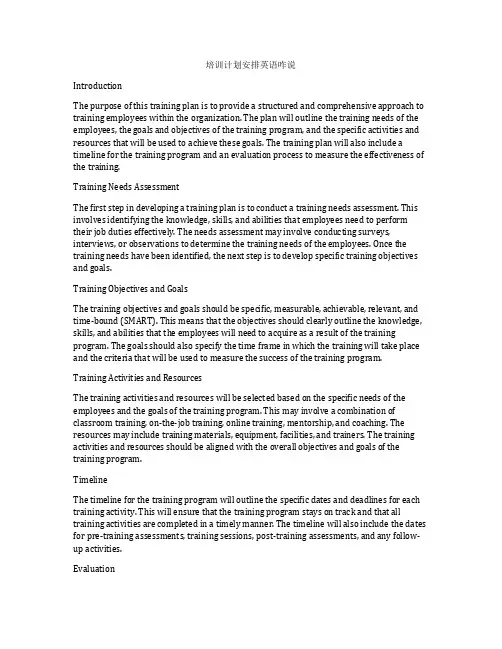
培训计划安排英语咋说IntroductionThe purpose of this training plan is to provide a structured and comprehensive approach to training employees within the organization. The plan will outline the training needs of the employees, the goals and objectives of the training program, and the specific activities and resources that will be used to achieve these goals. The training plan will also include a timeline for the training program and an evaluation process to measure the effectiveness of the training.Training Needs AssessmentThe first step in developing a training plan is to conduct a training needs assessment. This involves identifying the knowledge, skills, and abilities that employees need to perform their job duties effectively. The needs assessment may involve conducting surveys, interviews, or observations to determine the training needs of the employees. Once the training needs have been identified, the next step is to develop specific training objectives and goals.Training Objectives and GoalsThe training objectives and goals should be specific, measurable, achievable, relevant, and time-bound (SMART). This means that the objectives should clearly outline the knowledge, skills, and abilities that the employees will need to acquire as a result of the training program. The goals should also specify the time frame in which the training will take place and the criteria that will be used to measure the success of the training program.Training Activities and ResourcesThe training activities and resources will be selected based on the specific needs of the employees and the goals of the training program. This may involve a combination of classroom training, on-the-job training, online training, mentorship, and coaching. The resources may include training materials, equipment, facilities, and trainers. The training activities and resources should be aligned with the overall objectives and goals of the training program.TimelineThe timeline for the training program will outline the specific dates and deadlines for each training activity. This will ensure that the training program stays on track and that all training activities are completed in a timely manner. The timeline will also include the dates for pre-training assessments, training sessions, post-training assessments, and any follow-up activities.EvaluationThe evaluation process will measure the effectiveness of the training program and provide feedback for continuous improvement. This may involve conducting pre-training assessments to measure the employees' existing knowledge, skills, and abilities, as well as post-training assessments to measure the impact of the training program. The evaluation process may also involve gathering feedback from the employees and their supervisors to identify any areas for improvement.Training Plan ScheduleBased on the training needs assessment, the following training plan schedule has been developed:Training Objective: Improve Customer Service SkillsGoal: Increase customer satisfaction ratings by 10% within 6 monthsTraining Activities:1. Classroom training on effective communication and problem-solving skills2. On-the-job training with experienced customer service representatives3. Role-playing exercises to practice handling difficult customer situations4. Computer-based training on company policies and proceduresResources:- Training materials on effective communication and problem-solving- Computer training software on company policies and procedures- Experienced customer service representativesTimeline:- Pre-training assessments: Week 1- Classroom training: Weeks 2-4- On-the-job training: Weeks 5-8- Role-playing exercises: Weeks 9-10- Computer-based training: Week 11- Post-training assessments: Week 12Evaluation:- Pre-training and post-training assessments- Customer satisfaction surveys- Feedback from employees and supervisorsTraining Objective: Enhance Leadership SkillsGoal: Increase employee engagement and retention by 15% within 9 months Training Activities:1. Leadership development workshops on effective communication and team building2. Mentorship and coaching with senior managers3. Project management training4. Conflict resolution trainingResources:- Leadership development materials- Project management training materials- Experienced senior managers for mentorship- Conflict resolution training materialsTimeline:- Pre-training assessments: Week 1- Leadership development workshops: Weeks 2-5- Mentorship and coaching: Weeks 6-8- Project management training: Weeks 9-12- Conflict resolution training: Weeks 13-14- Post-training assessments: Week 15Evaluation:- Pre-training and post-training assessments- Employee engagement surveys- Feedback from employees and supervisorsConclusionThe training plan schedule outlined above provides a systematic approach to training employees within the organization. By identifying the specific training needs of the employees, setting clear objectives and goals, and selecting appropriate training activities and resources, the organization can ensure that the training program is effective in improving employee knowledge, skills, and abilities. The timeline and evaluation process will also help to measure the impact of the training program and identify any areas for improvement. By following this training plan schedule, the organization can enhance the overall performance and productivity of its employees.。
游泳训练计划英文术语
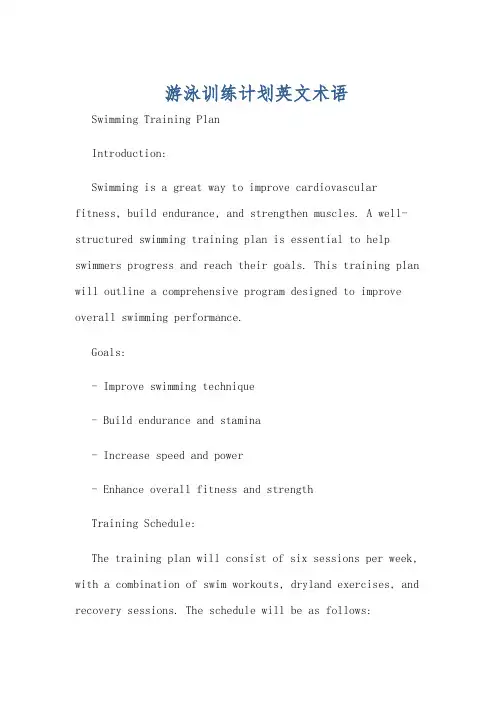
游泳训练计划英文术语Swimming Training PlanIntroduction:Swimming is a great way to improve cardiovascular fitness, build endurance, and strengthen muscles. A well-structured swimming training plan is essential to help swimmers progress and reach their goals. This training plan will outline a comprehensive program designed to improve overall swimming performance.Goals:- Improve swimming technique- Build endurance and stamina- Increase speed and power- Enhance overall fitness and strengthTraining Schedule:The training plan will consist of six sessions per week, with a combination of swim workouts, dryland exercises, and recovery sessions. The schedule will be as follows:Monday: Swim workout (technique focus)Tuesday: Dryland exercises (strength and conditioning) Wednesday: Swim workout (endurance focus)Thursday: Recovery session (light swim or rest)Friday: Swim workout (speed and power)Saturday: Dryland exercises (core strength and flexibility)Sunday: Swim workout (mixed focus)Training Components:1. Swim Workouts:These sessions will focus on improving swimming technique, building endurance, and increasing speed. Each workout will include a warm-up, main set, and cool down. The main set will consist of a combination of distance swimming, interval training, and sprint sets to target different energy systems and improve overall performance.2. Dryland Exercises:Dryland workouts will include a variety of exercises to improve strength, power, and flexibility. These may includeweight training, resistance band exercises, core workouts, and stretching. Dryland sessions are important for swimmers to develop overall strength and reduce the risk of injury.3. Recovery Sessions:Recovery sessions are crucial for swimmers to rest and repair their muscles. These sessions may include light swimming, yoga, or other low-impact activities to promote recovery and reduce muscle soreness.Progression:The training plan will be structured in phases to allow for progression and adaptation. Each phase will focus on specific goals and gradually increase in intensity and volume. The progression will be carefully monitored to ensure swimmers are making consistent improvements while minimizing the risk of overtraining or burnout.Nutrition and Hydration:Proper nutrition and hydration are essential for swimmers to fuel their workouts and aid in recovery. Swimmers should focus on consuming a balanced diet with adequate carbohydrates, proteins, and healthy fats.Hydration is also crucial, and swimmers should aim to drink plenty of water before, during, and after training sessions.Injury Prevention:Injury prevention will be a key focus of the training plan. Swimmers will be educated on proper warm-up and cool down techniques, stretching exercises, and recovery strategies to minimize the risk of injuries. Additionally, swimmers will be encouraged to listen to their bodies and communicate any discomfort or pain to their coaches.Conclusion:This swimming training plan is designed to help swimmers improve their overall performance through a combination of swim workouts, dryland exercises, and recovery sessions. By following this comprehensive plan, swimmers can expect to see improvements in technique, endurance, speed, andoverall fitness. Consistency, dedication, and proper recovery will be essential for success in this training program.游泳训练计划介绍:游泳是提高心血管健康、增强耐力和肌肉力量的绝佳方式。
培训计划的英文怎么写
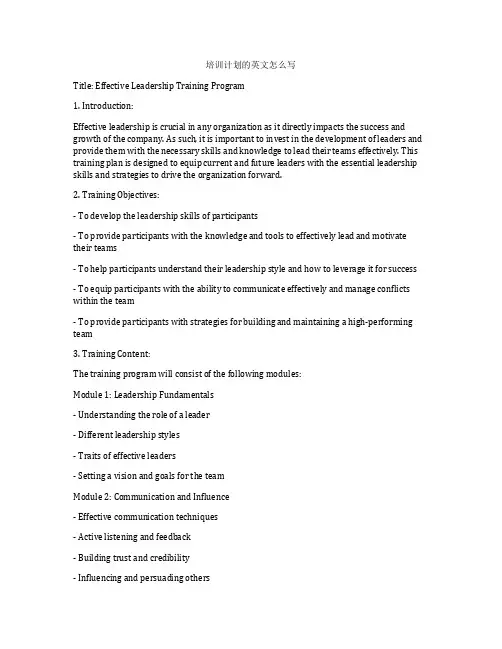
培训计划的英文怎么写Title: Effective Leadership Training Program1. Introduction:Effective leadership is crucial in any organization as it directly impacts the success and growth of the company. As such, it is important to invest in the development of leaders and provide them with the necessary skills and knowledge to lead their teams effectively. This training plan is designed to equip current and future leaders with the essential leadership skills and strategies to drive the organization forward.2. Training Objectives:- To develop the leadership skills of participants- To provide participants with the knowledge and tools to effectively lead and motivate their teams- To help participants understand their leadership style and how to leverage it for success - To equip participants with the ability to communicate effectively and manage conflicts within the team- To provide participants with strategies for building and maintaining a high-performing team3. Training Content:The training program will consist of the following modules:Module 1: Leadership Fundamentals- Understanding the role of a leader- Different leadership styles- Traits of effective leaders- Setting a vision and goals for the teamModule 2: Communication and Influence- Effective communication techniques- Active listening and feedback- Building trust and credibility- Influencing and persuading othersModule 3: Team Building and Motivation- Building a high-performing team- Motivating and engaging team members- Resolving conflicts within the team- Building a positive team cultureModule 4: Strategic Thinking and Decision Making- Thinking strategically- Making effective decisions- Managing risk and uncertainty- Setting priorities and managing time effectivelyModule 5: Coaching and Mentoring- Coaching and mentoring skills- Providing feedback for growth and development- Developing the potential of team members- Creating a learning culture within the team4. Training Methods:The training program will utilize a variety of training methods to engage participants and facilitate a dynamic learning experience. These methods include:- Interactive workshops and discussions- Case studies and simulations- Role-playing and group activities- Self-assessment tools and reflection exercises- Guest speakers and industry experts5. Training Schedule:The training program will be conducted over a period of 6 months to allow participants to apply their learning in their day-to-day work. Each module will be delivered in a 2-day workshop format, with additional self-study and practice exercises in between sessions.6. Evaluation and Feedback:Participant progress and learning will be continuously monitored and evaluated throughout the program. Feedback will be collected after each module to identify strengths and areas for improvement. Pre- and post-training assessments will be conducted to measure the impact of the training on participants' leadership skills and performance.7. Conclusion:Effective leadership is essential for driving the success of any organization. By investing in the development of leaders and providing them with the necessary skills and knowledge, companies can ensure the growth and sustainability of their business. This training program aims to empower leaders with the essential leadership skills and strategies to lead their teams effectively and achieve organizational goals.8. References:- "The 7 Habits of Highly Effective People" by Stephen R. Covey- "Leaders Eat Last: Why Some Teams Pull Together and Others Don't" by Simon Sinek- "Leadership and Self-Deception: Getting Out of the Box" by The Arbinger Institute- "The Five Dysfunctions of a Team: A Leadership Fable" by Patrick LencioniThis training plan is designed to equip current and future leaders with the necessary skills and knowledge to lead their teams effectively. By providing them with the right tools and strategies, organizations can ensure the growth and success of their business.。
跟随培训计划英文怎么说
跟随培训计划英文怎么说IntroductionOn-the-job training (OJT) is a practical way for employees to acquire knowledge, skills, and experience in a specific field or job role. It provides an opportunity for employees to learn and develop their abilities by working alongside experienced professionals.This training plan aims to outline the process and structure of the OJT program, detailing the objectives, activities, and evaluation methods. The plan will ensure that employees receive comprehensive training and support in order to maximize their learning and growth.Objectives of the Training ProgramThe main objectives of the OJT program are as follows:1. To provide employees with the necessary knowledge and skills to perform their job roles effectively.2. To familiarize employees with the company's policies, procedures, and work environment.3. To enable employees to work independently and confidently in their respective roles.4. To facilitate the personal and professional development of employees through mentorship and hands-on experience.Program StructureThe OJT program will be structured as follows:1. Selection of Participants:Employees who are new to their job roles or require additional training will be selected to participate in the OJT program. The selection process will be based on the employee's performance, readiness, and potential to benefit from the program.2. Assignment of Mentors:Each participant will be paired with an experienced mentor who will guide and support them throughout the training process. Mentors will be chosen based on their expertise, communication skills, and willingness to help others.3. Training Schedule:The OJT program will have a predetermined schedule for participants to follow. This will include the duration of the training, specific tasks to be completed, and regular check-ins with mentors and supervisors.4. Training Activities:Participants will engage in various training activities, including shadowing their mentors, hands-on practice, attending workshops or seminars, and completing assigned projects or tasks.5. Evaluation and Feedback:Participants' progress will be evaluated through assessments, feedback from mentors, and performance reviews. This will help to identify areas for improvement and tailor the training to meet individual needs.Training PlanThe following is a detailed plan for the OJT program, including the training activities, timeline, and evaluation methods.Week 1:- Introduction to the company's policies, procedures, and organizational structure.- Shadowing the mentor to observe daily tasks and responsibilities.- Setting expectations and goals for the training period.Week 2:- Hands-on practice of specific job tasks under the guidance of the mentor.- Participating in team meetings and discussions to gain a better understanding of the work culture.Week 3:- Attending workshops or training sessions on relevant topics such as customer service, communication skills, or technical skills.- Completing assigned projects or tasks to apply learning in a real-world setting.Week 4:- Continued practice and refinement of job tasks.- Mid-term evaluation and feedback session with the mentor and supervisor to review progress and discuss any challenges or concerns.Week 5:- Participation in job shadowing with other professionals within the company to gain a broader perspective.- Engaging in self-directed learning and research to deepen understanding of the role and industry.Week 6:- Finalizing any outstanding projects or tasks.- Conducting a final evaluation and feedback session with the mentor and supervisor to assess learning outcomes and identify areas for further development.Evaluation and MeasurementThe success of the OJT program will be measured through several key indicators, including: - Participant performance and competency in their job roles.- Feedback from mentors, supervisors, and peers on the progress of the participants.- Completion of assigned projects and tasks within the timeline and with acceptable quality. - Participant satisfaction and confidence in their abilities to perform their roles effectively. ConclusionThe OJT program is a valuable opportunity for employees to gain practical experience and develop their skills in a supportive environment. By following this training plan, participants will have a clear path to learning and growth, ultimately benefiting both the employees and the organization as a whole.。
New Staff Training Schedule模板
类别时间课程主要内容课时
自我介绍★欢迎新员工及自我介绍
★培训安排&培训纪律1
公司介绍★集团简介及arvato介绍(运营组织架构)1公司介绍★员工福利、员工守则1
职业规划★客服人员岗位职责
★快速成长通道
★分阶段员工培训介绍
1
职业相关介绍★客户&客户服务是什么
★客户流失的原因
★优质客户服务的六大原则
1
Review★演讲回顾第一天所学内容(考核一)1在线服务技巧★声音、语气1
第二天下午在线服务技巧
★有效聆听
★专业表达
★提问
3 OB话术
★ Data cleansing的目的、重要性
★如何进行Data cleansing1客户投诉处理技能
★投诉处理流程
★如何处理特殊客户的来电
★3.15期间的注意事项
1
第三天下午考试
★笔试(新员工入职考试)
★口试(Data cleansing OB/IB)3
Training Schedule
New Staff Training 第一天下午第一天上午第二天上午
第三天上午
e
目的
◆公司服务中心目前项目架构与基本运营情况;
◆员工福利、服务中心员工行为规范准则;
◆员工福利、服务中心员工行为规范准则;
◆一线员工工作职责;
◆职业发展基本规划;
◆具备基本的客户服务意识
◆考核
◆学会塑造专业的客服声音及语气
◆掌握一线表达规范和基本礼仪
◆掌握Data cleansing的重点及如何进行Data cleansing OB
◆掌握处理客户投诉的基本技能与意识
◆具备一线警惕意识
◆考核。
教职工气排球培训方案及训练计划
教职工气排球培训方案及训练计划Title: Staff Volleyball Training ProgramIntroduction:The staff volleyball training program aims to improve the skills and fitness levels of the faculty members. This program will not only enhance teamwork and camaraderie among the staff, but also promote physical well-being and a healthy lifestyle.Training Objectives:1. Develop fundamental volleyball skills such as serving, passing, setting, and spiking.2. Enhance agility, speed, and coordination.3. Improve teamwork and communication on the court.4. Increase overall fitness levels and endurance.Training Schedule:The training program will be conducted twice a week, with each session lasting for 1.5 hours. The schedule will be flexible to accommodate the availability of the staff members.Training Activities:1. Warm-up exercises: Participants will engage in dynamic stretching and cardio exercises to prepare their muscles for the training session.2. Skill drills: Various drills will be conducted to improve serving, passing, setting, and spiking techniques. These drills will focus on accuracy, control, and consistency.3. Game scenarios: Participants will engage in simulated game situations to practice their skills in a realistic setting. This will help develop decision-making abilities and teamwork.4. Strength and conditioning: Specific exercises will be included to improve overall strength, speed, and endurance. These exercises may include circuit training, plyometrics, and interval training.5. Cool-down and stretching: Participants will perform static stretching exercises to cool down their muscles and prevent injuries.Progress Monitoring:Regular assessments will be conducted to track the progress of each participant. This will include individual skill evaluations, fitness tests, and game performance analysis. Feedback and guidancewill be provided to help individuals improve their weaknesses and build on their strengths.Conclusion:The staff volleyball training program provides a structured and comprehensive approach to enhance the skills and fitness levels of the faculty members. By participating in this program, staff members will not only improve their volleyball abilities but also enjoy the benefits of a healthy and active lifestyle.中文回答:标题:教职工气排球训练计划介绍:教职工气排球训练计划旨在提高教职工的技能和身体素质。
training-schedule
Day1AM
Day1PM
Day1 PM– Day2 AM
Day2AM
Day2PM
Day3AM
No
Section
Topic list
Schedule
Trainer
3.
Organizational Structure & Master Data in MM
3.FICO_Account&Line Items
4.FICO_Tax
Master Data in FI
Financial Document Postings & Edit
Account Balance and Line item display
Tax on Sales & Purchase
Day 2– AM
Topic Three Material Valuation
Topic Four: Procurement
Topic Five: Reporting and Analysis/ review
Day6AM
Day6PM
Day7AM
Day7AM
Day7 PM
FI/CO Training Schedule
Time : Nov. 2nd, 2000–Nov. 10th, 2000
(MM03)
Purchasing Information Records
Conditions
Source List
Day5PM
Day6AM
Day6AM
6.
Miscellaneous
(MM04)
Topic One: Goods Receipt
- 1、下载文档前请自行甄别文档内容的完整性,平台不提供额外的编辑、内容补充、找答案等附加服务。
- 2、"仅部分预览"的文档,不可在线预览部分如存在完整性等问题,可反馈申请退款(可完整预览的文档不适用该条件!)。
- 3、如文档侵犯您的权益,请联系客服反馈,我们会尽快为您处理(人工客服工作时间:9:00-18:30)。
ZhouZhenQi
30 March 2010
©2009. Renesas Technology Corp., All rights reserved.
Schedule 1: -29th March
29th Mar. (Internal Meeting) 13:00-13:10 Introduce each other; 13:10-13:50 Introduce customer status by Daniel Chen; 14:00-16:30 Internal technical training for RT-SH staffs by Inui san; 17:00-17:30 Introduce Ultra-view questions in advance for Inui san.
3
©2009. Renesas Technology Corp., All rights reserved.
Schedule 3: -31th March
31th Mar.: (Ultraview 4 engineers) 09:00-11:00 Discuss project software structure, uITRON task assignment; System optimize, attention from M32C/MR308 to R32C/MR100 etc; 11:00-12:00 Review and summary.
6
©2009. Renesas Technology Corp., All rights reserved.
Thank you!
©2009. Renesas Technology Corp., All rights reserved.
2
©2009. Renesas Technology Corp., All rights reserved.
Schedule 2: -30th March
30-12:00 Introduce R32C/117 and MR100; Excercises; Introduce difference between MR100 and MR308. 13:00-18:00 Ultraview introduce project status and structure idea; Ultra-view explains their questions and discussion;
4
©2009. Renesas Technology Corp., All rights reserved.
Questions From Ultraview
1>How to setup MR100 in HEW & create workspace for R32C/117. 2>MR100 OS kernel introduction, how to calculate system resource(Stack size-User stack & System stack) in MR100? 3>Common object explanation 4>How to configurate minimum system(initialization, clock configurator, low power mode configurator) 5>How to develop peripheral driver, include some common driver(UART, IIC, SPI, Hardware Parallel port, A/D, CAN Bus)
5
©2009. Renesas Technology Corp., All rights reserved.
Questions From Ultraview
6>P2 Samand task suggestion (GUI task, Audio task, Radio task, USB player task, AUX input task, CD task, air con player task, BlueTooth audio management task, BlueTooth call management task & BlueTooth management task) 7>How to package source code & how to use library.
